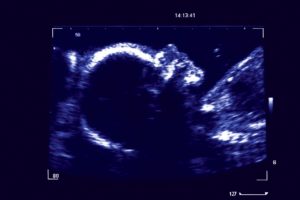Pregnant women know ultrasound very well – after all, it is the imaging method of choice in the veritable examination marathon during pregnancy. Doppler sonography is a special ultrasound procedure.
By means of this method, the blood flow to the placenta and the blood supply to the unborn child can be reliably monitored. The examination is also called Doppler sonography and is mainly used from the 38th week of pregnancy onwards, since towards the end of pregnancy there can be increased circulatory disturbances and thus supply bottlenecks for the fetus.
In this article, you can find out exactly how Doppler sonography works and what specific areas of application there are.
Table of contents
What Does Doppler Sonography Mean?
Doppler sonography is the visualization of blood vessels in ultrasound. It is possible to show the position and patency of blood vessels as well as the direction and speed of blood flow in color.
Because of this, this examination is also called color-coded Doppler sonography. Other common terms for this examination are Doppler sonography, Doppler ultrasound or simply Doppler.
In medical vernacular, Doppler sonography and Doppler ultrasonography are often used interchangeably. However, there is a subtle difference:
The term duplex sonography can be derived from the Latin word “duplex”, which means “ double”. This term refers to the fact that Doppler sonography mixes two sonographic procedures.
On the one hand, the so-called B-scan is displayed, i.e. a completely normal black-and-white-gray ultrasound image without color-coding. On the other hand, the color-coded information about the blood flow is also shown. Both images are superimposed in real-time and thus allow a variety of statements to be made.
The term Doppler sonography, on the other hand, refers to the Austrian physicist Christian Doppler, who in 1842 discovered the Doppler effect named after him, which is the basis for the color-coded sonographic examination of blood.
Strictly speaking, therefore, Doppler sonography refers only to the color image sections, but without tissue information. The physical phenomenon of the Doppler effect refers to the compression and stretching of an acoustic or visual signal as the distance between the signal transmitter and signal receiver changes.
It occurs, for example, when an emergency vehicle drives past you with its siren on. You have probably already noticed that the siren sounds higher when the ambulance is approaching you and suddenly becomes lower as soon as it has passed. Physically, this fact can be explained like this: If the rescue car is coming towards you, it “pushes” the sounds in your direction.
The resulting shorter wavelength means a higher frequency and thus a higher tone. Conversely, the wavelength lengthens as soon as the ambulance passes you and moves away from you again. This also means that the frequency and pitch of the sound are lower.
How Does Doppler Sonography Work?
Doctors make use of the Doppler effect just described. The ultrasound device recognizes whether the blood is flowing toward or away from the ultrasound probe because the associated wavelengths and frequencies differ.
Accordingly, there are color differences and the physician can see on the screen in which direction the blood is flowing at the site just examined. This is used, for example, to differentiate between arteries and veins or to detect flow disturbances.
Typically, blood flowing toward the transducer is shown in red, and blood flowing away from the transducer is shown in blue. This is a standardized procedure to make comparisons possible and to avoid confusion.
In addition, the blood flow is also displayed auditorily, i.e. with sounds. Your doctor can thus assess the blood flow, the direction of flow and the heart rate even more precisely.
How Does The Examination By Doppler Sonography Work?
Doppler sonography differs from other ultrasound examinations only physically and technically. For you as a patient, however, it proceeds in exactly the same way as any other ultrasound examination.
For this, the doctor will smear a slippery gel on the area to be examined and glide over it with a small detector called a transducer. In the process, he has to apply more or less pressure to get a nice ultrasound image. An examination by Doppler sonography takes about 10 minutes.
When Is Doppler Ultrasonography Used?
Generally, Doppler ultrasound is considered whenever questionable circulatory or cardiac dysfunction is involved. Classic questions are:
- Function of the heart valves and condition of the atria and ventricles of the heart.
- Questionable stenosis or occlusion of the carotid artery (neck vessel).
- Questionable DVT (thrombosis of a deep leg vein).
- Resistance index in the renal vessels (in hypertension).
Doppler ultrasound is also used in obstetrics. Especially in the later stages of pregnancy, Doppler ultrasound is used to check the proper perfusion of the placenta and the function of the fetal circulation.
Especially towards the end of the third trimester, around the 38th week of pregnancy, these checks are carried out more closely, as there may already be reduced placental function and thus an undersupply of the unborn child. Doppler sonography is also used to assess the risk of preeclampsia or HELLP syndrome.
Special Functions In Doppler Sonography
Doppler sonography has evolved over time and new functions have been added. For example, modern ultrasound machines are equipped with the additional functions of CW Doppler (continuous wave Doppler or tissue Doppler) and PW Doppler (power Doppler) to obtain a variety of information.
CW Doppler
Continuous Wave Doppler is used to show not only blood flow, but also tissue movement. However, no depth information can be obtained with CW Doppler.
PW Doppler
Power Doppler not only shows velocity and direction of flow but also allows conclusions about the kinetic energy. The special feature here is that the location of the imaging is selected in the tissue. This location is also called “gate” in radiological terminology. Measurements are taken only at the depth determined in this way.
The Advantages And Disadvantages Of Doppler Sonography
A decisive advantage, especially for pregnant women, is the low-risk nature of sonography. Ultrasound works with sound waves that are not radioactive, unlike the radiation used in X-rays or computer tomography. There is therefore no cell-damaging effect from X-rays. This fact makes sonography the imaging method of choice for pregnant women.
One disadvantage of the examination is that while it can provide precise information on specific issues, it fails when it comes to detailed imaging of tissue. You’ve probably already noticed that an ultrasound image is very blurry and it’s almost impossible for a layperson to make out anything on it.
Another disadvantage is the risk of overheating in the examined tissue – but this can usually only happen if the examination periods are very extended in time, for example by an inexperienced doctor.
The increase in temperature can cause damage to the cerebral area, i.e. the brain or peripheral nervous system of the child. However, you do not have to worry in general, because such incidents happen extremely rarely and are virtually impossible under normal examination conditions and also with closer monitoring.
If further information is required that cannot be obtained by ultrasound, there are numerous alternative or supplementary examination options. For example, tissue can be removed by fine-needle biopsy and examined in more detail in the laboratory.
Another examination that does not require radioactive radiation is magnetic resonance imaging, or MRI for short. This procedure uses magnetic radiation, which is not considered to be harmful to cells. X-ray examinations are also conceivable if indicated, but are largely avoided because of the radioactive radiation.
Sources
http://www.pränatal-info.at/de/methoden-der-praenatalen-diagnostik/doppler-ultraschall.html
https://www.dr-fruehmann.at/schwangerschaft-geburt/doppler-ultraschall/
https://www.netdoktor.at/untersuchung/dopplersonographie-8259












